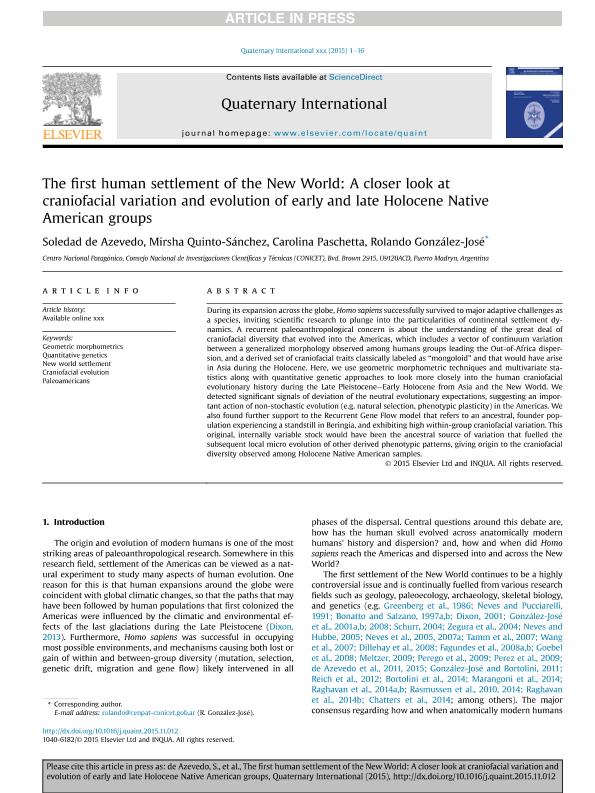Mostrar el registro sencillo del ítem
dc.contributor.author
de Azevedo, Soledad

dc.contributor.author
Quinto Sanchez, Mirsha Emmanuel

dc.contributor.author
Paschetta, Carolina Andrea

dc.contributor.author
González José, Rolando

dc.date.available
2018-05-10T14:35:57Z
dc.date.issued
2017-02
dc.identifier.citation
de Azevedo, Soledad; Quinto Sanchez, Mirsha Emmanuel; Paschetta, Carolina Andrea; González José, Rolando; The first human settlement of the New World: A closer look at craniofacial variation and evolution of early and late Holocene Native American groups; Pergamon-Elsevier Science Ltd; Quaternary International; 431; 2-2017; 152-167
dc.identifier.issn
1040-6182
dc.identifier.uri
http://hdl.handle.net/11336/44745
dc.description.abstract
During its expansion across the globe, Homo sapiens successfully survived to major adaptive challenges as a species, inviting scientific research to plunge into the particularities of continental settlement dynamics. A recurrent paleoanthropological concern is about the understanding of the great deal of craniofacial diversity that evolved into the Americas, which includes a vector of continuum variation between a generalized morphology observed among humans groups leading the Out-of-Africa dispersion, and a derived set of craniofacial traits classically labeled as ?mongoloid? and that would have arise in Asia during the Holocene. Here, we use geometric morphometric techniques and multivariate statistics along with quantitative genetic approaches to look more closely into the human craniofacial evolutionary history during the Late PleistoceneeEarly Holocene from Asia and the New World. We detected significant signals of deviation of the neutral evolutionary expectations, suggesting an important action of non-stochastic evolution (e.g. natural selection, phenotypic plasticity) in the Americas. We also found further support to the Recurrent Gene Flow model that refers to an ancestral, founder population experiencing a standstill in Beringia, and exhibiting high within-group craniofacial variation. This original, internally variable stock would have been the ancestral source of variation that fuelled the subsequent local micro evolution of other derived phenotypic patterns, giving origin to the craniofacial diversity observed among Holocene Native American samples. © 2015 Elsevier Ltd and INQUA.
dc.format
application/pdf
dc.language.iso
eng
dc.publisher
Pergamon-Elsevier Science Ltd

dc.rights
info:eu-repo/semantics/openAccess
dc.rights.uri
https://creativecommons.org/licenses/by-nc-sa/2.5/ar/
dc.subject
Geometric Morphometrics
dc.subject
Quantitative Genetics
dc.subject
New World Settlement
dc.subject
Craniofacial Evolution
dc.subject
Paleoamericans
dc.subject.classification
Otras Ciencias Biológicas

dc.subject.classification
Ciencias Biológicas

dc.subject.classification
CIENCIAS NATURALES Y EXACTAS

dc.title
The first human settlement of the New World: A closer look at craniofacial variation and evolution of early and late Holocene Native American groups
dc.type
info:eu-repo/semantics/article
dc.type
info:ar-repo/semantics/artículo
dc.type
info:eu-repo/semantics/publishedVersion
dc.date.updated
2018-05-02T18:14:52Z
dc.journal.volume
431
dc.journal.pagination
152-167
dc.journal.pais
Países Bajos

dc.journal.ciudad
Amsterdam
dc.description.fil
Fil: de Azevedo, Soledad. Consejo Nacional de Investigaciones Científicas y Técnicas. Centro Nacional Patagónico; Argentina
dc.description.fil
Fil: Quinto Sanchez, Mirsha Emmanuel. Consejo Nacional de Investigaciones Científicas y Técnicas. Centro Nacional Patagónico; Argentina
dc.description.fil
Fil: Paschetta, Carolina Andrea. Consejo Nacional de Investigaciones Científicas y Técnicas. Centro Nacional Patagónico; Argentina
dc.description.fil
Fil: González José, Rolando. Consejo Nacional de Investigaciones Científicas y Técnicas. Centro Nacional Patagónico; Argentina
dc.journal.title
Quaternary International

dc.relation.alternativeid
info:eu-repo/semantics/altIdentifier/doi/http://dx.doi.org/10.1016/j.quaint.2015.11.012
dc.relation.alternativeid
info:eu-repo/semantics/altIdentifier/url/https://www.sciencedirect.com/science/article/pii/S1040618215011209
Archivos asociados
